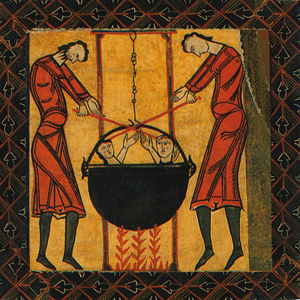
Being boiled in oil by your theory profs.
For each of these, I’ve posted the introductory material and the table of contents, so you can see what’s what. If you want to look at anything else, please contact me, and we’ll talk.
1) Species Counterpoint / 16th-century examples in 2 & 3 voices. (646 pages)
| Counterpoint Downloads | |
|---|---|
| A guide to species counterpoint – Anthology for analysis and sight-singing. Introduction and Table of Contents | click here |
| A guide to species counterpoint – Anthology for analysis and sight-singing. 646 pages. CDN $15.00 |
click here |
The basic idea behind species counterpoint is that it’s supposed to offer a systematic method for approaching the study of counterpoint in the Palestrina style. In practice, it never worked out that way. If we go by the examples in his famous “Gradus ad Parnassum,” even J.J. Fux, our historical point person, never managed to step away from the conventions of his own time, bounded as they were by the major-minor key system in a way that Palestrina’s music was not. And although species is still taught here and there, it is normally delivered by a theorist whose real agenda is in its application to Schenkerian analysis. In other words, although this is a study purportedly based on sixteenth-century music, it turns out that the actual music of that period is hardly looked at. Well, Fux didn’t know, so why should you?
What made my approach different is that I was actually interested in this repertoire. The book I put together consists of two parts. In the first, we have the usual rules for species writing, dissonance treatment, and so on, plus a bunch of CF’s and exercises, but leading only as far as three-voice writing in a combination of second species and fourth species (suspensions). One reason I stopped there is that there was simply no more time. Remember, the York students are expected to complete this whirlwind tour in only twelve weeks. But it’s also the case that this type of three-part writing does address a lot of the fundamental voice-leading problems we meet up with when studying harmony; so I figured that was far enough. The rest of the book is taken up with a ton of examples of two- and three-part writing from 16th-century writers, all of them supplied with solfa syllables (the York students couldn’t have functioned at all without them).
2) Bridge to Basic Harmony and Anthology for Analysis (583 pages)
| Harmony Downloads | |
|---|---|
| Bridge to Basic Harmony and Music for Analysis. Introduction and Table of Contents | click here |
| Bridge to Basic Harmony and Music for Analysis. 583 pages. CDN $15.00 |
click here |
Students usually go directly from a study of the rudiments of the notation system – key signatures, time signatures, scales, how to write rest and notes, etc. – directly into a course on 4-part harmony. For most students, it’s a bit overwhelming, but for the York students it was even more so. What’s missing is a way of leading in a more logical manner from the basic notational and conceptual tools to the point where you can handle chord progressions and harmonize melodies. More important, unless one learns to apply this knowledge to actual music, then studying of harmony is like studying literature without reading a book. If I had to prioritize things – and at York I did – then I would say that it’s more important to get the students to the point where they can look at a piece of music than to have them scribble through an exercise in SATB writing. In fact, I figure that for a lot of these students, this is probably their only kick at the can in terms of studying anything by Beethoven, Mozart.
Obviously, with so many examples included here, there was never an idea that we would cover more than a fraction of the material. That was fine with me, because at the end of the day, any student with a legatimate interest in the music of these masters will have, in this book, a huge treasury of music to explore long after the course is over.
All of this by way of suggesting what you can expect. There are some interesting ideas about theory, ideas intended to set you up fairly quickly so that you can start looking at real music. In the course for which I designed this book, 2202 Harmony, I also had the students purchase Clough and Conley’s Basic Harmonic Progressions, largely because it’s a programmed text.